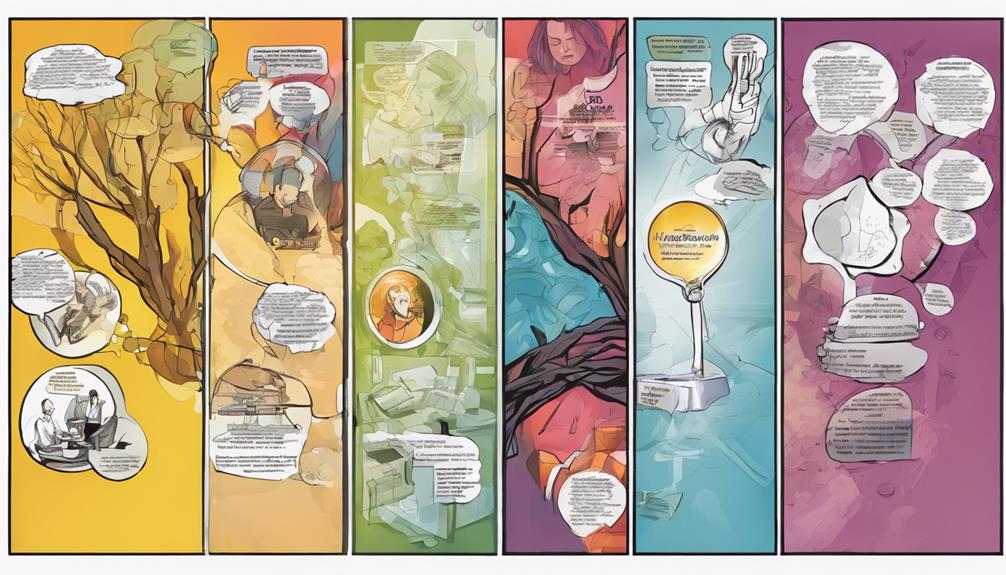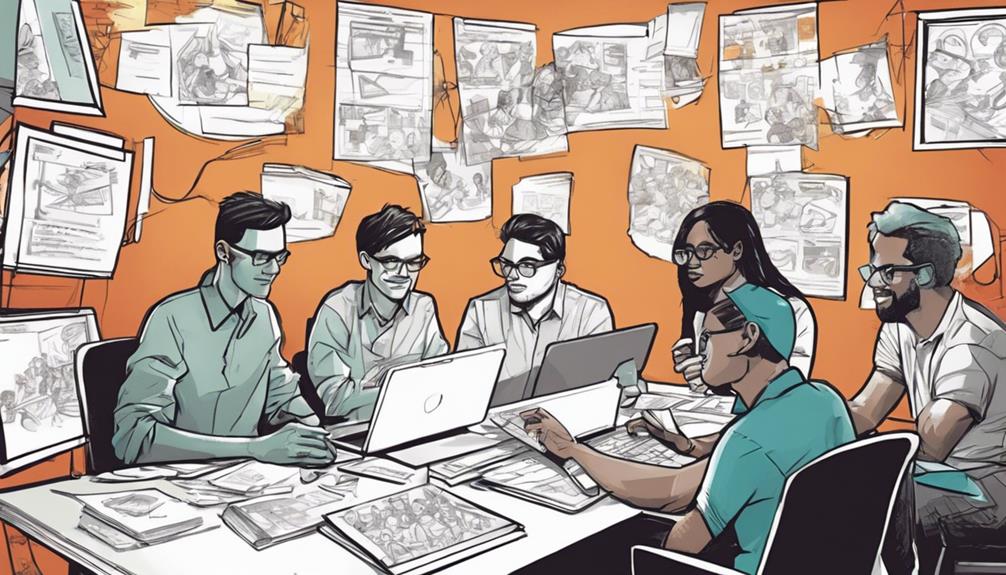If you're curious about Design Thinking, it's a user-centered method focusing on empathy, defining problems, ideating solutions, and prototyping. Key principles like human-centricity and out-of-the-box thinking drive its success in fostering innovation and collaboration. This innovative approach has evolved from a focus on creativity to a holistic problem-solving strategy utilized by industries like technology, healthcare, and finance. Companies such as IBM, Airbnb, and Nike have leveraged design thinking to enhance customer satisfaction and drive innovation. Interested to discover more about its impact and application in various sectors?
Key Takeaways
- Design thinking is a user-centered approach to problem-solving.
- It involves empathizing, defining, ideating, prototyping, and testing.
- Key principles include human-centricity, creativity, and prototyping.
- Design thinking fosters innovation, collaboration, and out-of-the-box thinking.
- Industries like technology, healthcare, and finance benefit from design thinking methodologies.
What Is Design Thinking?
Design thinking, a problem-solving approach, focuses on understanding user needs and creating innovative solutions. This iterative process involves empathizing with users, defining the problem, ideating potential solutions, prototyping ideas, and testing them.
Companies like Google, Apple, and Airbnb leverage design thinking to enhance user experiences and drive innovation. By prioritizing user-centric solutions, design thinking tackles complex, undefined problems effectively. Creativity, empathy, and collaboration are key elements in this approach, emphasizing the importance of developing practical and impactful solutions.
Design thinking isn't a linear process; it encourages thinking outside the box and iterating on ideas to find the best possible solutions. By understanding and addressing user needs creatively and empathetically, companies can develop products and services that truly resonate with their target audience, setting themselves apart in a competitive market.
Importance of Design Thinking

To grasp the importance of design thinking, consider how it fosters innovation and collaboration in problem-solving processes. Design thinking emphasizes understanding users' needs through thorough user research, enabling the development of creative and innovative solutions. By challenging assumptions and testing ideas, this approach ensures that solutions effectively address the problems at hand.
Moreover, design thinking promotes collaboration within teams by encouraging diverse perspectives and co-creation, leading to more robust and impactful outcomes. Companies such as Google, Apple, and Airbnb leverage design thinking to drive innovation and enhance their products and services. Through this methodology, they continuously innovate and stay ahead in the market by creating user-centric solutions that resonate with their target audience.
Evolution of Design Thinking

Over the past few decades, the evolution of design thinking has been closely intertwined with the changing landscape of problem-solving methodologies and innovation strategies.
Design thinking, as a problem-solving methodology, emphasizes creativity and innovation in addressing challenges. Tim Brown's influential work, particularly his book 'Change by Design,' played a pivotal role in popularizing the concept of design thinking as a human-centered approach to problem-solving.
About 15 years ago, design thinking gained significant traction, especially after Tim Brown's contributions to the Harvard Business Review. His insights and advocacy for human-centered design principles further propelled the evolution of design thinking into a widely recognized and utilized framework for tackling complex problems.
This evolution signifies a shift towards more collaborative, empathetic, and iterative problem-solving processes that prioritize understanding the needs of end-users and fostering innovation to create impactful solutions.
Key Design Thinking Rules

Understand and apply the key rules of design thinking to enhance your problem-solving approach effectively. When engaging in design thinking, remember these essential rules:
- Human Rule: The foundation of design thinking lies in the human principle, where the focus is on understanding and meeting the needs of end users. By empathizing with users, you can create solutions that truly resonate and address their challenges effectively.
- Ambiguity Rule: Embrace the uncertainty rule to encourage thinking outside the box. Explore unconventional solutions and perspectives to tackle problems from new angles, fostering creativity and innovation in your design process.
- Tangibility Rule: The tangibility principle emphasizes the importance of prototyping to communicate and test ideas. By creating tangible representations of your concepts, you can gather feedback early on, iterate efficiently, and guarantee that your solutions align with user expectations. Remember, prototyping is a powerful tool in refining and validating your design solutions.
Design Thinking Process Phases

You're about to uncover the key phases of the Design Thinking process:
- Empathize
- Define
- Ideate
- Prototype
- Test
These phases will guide you through understanding user needs, framing the problem, generating creative solutions, and building prototypes for validation.
Prototyping for Validation
During the prototyping phase in the design thinking process, teams create tangible representations to validate proposed solutions. This step is vital as it allows for a hands-on approach to testing and refining ideas before moving forward.
Here are three key aspects of prototyping for validation:
- Gathering Feedback: Prototyping enables teams to collect feedback from users early on, aiding them in understanding user needs and preferences. This feedback loop is essential for improving and iterating on designs to guarantee they meet user expectations.
- Reducing Uncertainty: By creating prototypes, teams can identify potential issues and uncertainties in the proposed solutions. Addressing these early on helps in minimizing risks and uncertainties before investing significant time and resources into full-scale development.
- Verifying Feasibility: Prototyping helps in evaluating the feasibility of proposed solutions. It allows teams to test concepts and functionalities, ensuring that the final product will be viable and effective in addressing the identified problem.
Iterative Problem-Solving
The iterative problem-solving approach in the design thinking process involves five key phases that guide teams through understanding user needs, defining problems, generating ideas, building prototypes, and testing solutions.
Design thinking steps, including Empathize, Define, Ideate, Prototype, and Test, form an iterative process aimed at solving real user problems.
Through this method, teams redefine the original problem based on insights gathered during the empathize phase, ensuring solutions are tailored to user needs.
By iterating on ideas and prototypes, teams can generate innovative solutions that address user concerns effectively.
The phases of design thinking allow for continuous refinement based on user feedback, ensuring that the final product meets user expectations.
This iterative nature of the process enables teams to adapt, pivot, and refine their approach to developing solutions, ultimately leading to impactful and user-centered outcomes.
Fundamentals of Design Thinking

Understanding the fundamentals of design thinking is necessary for mastering the problem-solving approach centered around consumer needs and innovative solutions.
When delving into the design thinking process, you'll encounter key elements that are critical for its successful implementation:
- User-Centricity: Design thinking revolves around understanding user needs and preferences to develop solutions that truly cater to them.
- Ideation and Prototyping: Brainstorming and creating prototypes are important steps in the design process to generate and refine innovative ideas before finalizing solutions.
- Testing and Implementation: To ensure the effectiveness of the proposed solutions, testing them with real users and implementing the best one is essential for achieving success.
Application of Design Thinking

You can apply design thinking across industries to analyze its impact, foster collaborative problem-solving, and catalyze innovation.
By utilizing this approach, you can tailor solutions that address specific user needs and drive successful outcomes.
Industry Impact Analysis
Design thinking has greatly transformed various industries by enhancing user experiences and fostering innovation. When applied effectively, it has the potential to revolutionize industries, driving business growth through innovative approaches and user-centric solutions.
Here are some key impacts of design thinking on industries:
- Successful Products: Companies such as IBM, Airbnb, and Nike have leveraged design thinking to create products and services that not only meet but exceed user expectations, leading to commercial success.
- Enhance Customer Satisfaction: By focusing on human-centered design principles, design thinking has helped industries improve customer satisfaction levels by delivering products and services that truly address user needs and preferences.
- Industry Impact: Design thinking methodologies have been instrumental in transforming sectors like technology, healthcare, finance, education, government, and retail, instigating a shift towards collaborative problem-solving and innovative solutions.
Collaborative Problem-Solving
Fostering collaboration among diverse teams is a key aspect of applying design thinking in problem-solving scenarios. By bringing together individuals from different backgrounds and areas of expertise, design thinking encourages the integration of diverse perspectives to address complex challenges effectively. Cross-functional teams work collectively to understand user needs, identify user pain points, and develop innovative solutions that resonate with the target audience. This collaborative problem-solving approach not only promotes teamwork and communication but also instills a sense of shared ownership in the problem-solving process.
| Key Aspects of Collaborative Problem-Solving | |
|---|---|
| Diverse Perspectives | Addressing challenges from various angles |
| User Needs | Understanding and meeting user requirements |
| Innovative Solutions | Developing out-of-the-box ideas |
| Teamwork | Working together towards a common goal |
Innovation Catalyst Approach
Utilizing design thinking as an innovation catalyst is instrumental in driving creative problem-solving and fostering a culture of innovation within organizations.
The Innovation Catalyst Approach focuses on understanding user needs, ideating creative solutions, and testing prototypes. It encourages cross-functional collaboration and diverse perspectives to generate innovative ideas.
By applying design thinking principles, organizations can uncover new opportunities and develop impactful solutions that address real user needs effectively. This approach aims to transform challenges into opportunities for growth and success.
Through a structured process of empathy, ideation, prototyping, and testing, the Innovation Catalyst Approach ensures that solutions aren't only innovative but also practical and user-centric.
Execution and Implementation of Design Thinking

During the execution and implementation phase of design thinking, the focus shifts towards translating the vision into actionable steps while maintaining flexibility for adaptability.
This phase involves moving from ideation to the prototype stage, where tangible representations are built to gather user feedback for refinement.
Testing plays a pivotal role in verifying user needs and applying the lean startup methodology for continuous improvement through iterative development.
Implementation is key in design thinking, as it guarantees the proper execution of the solutions while embracing flexibility throughout the process.
User feedback is highly valued in this stage, driving the iteration process and emphasizing adaptability for effective problem-solving.
Design thinking promotes an iterative approach that's user-centered, allowing for the implementation of innovative solutions that meet the evolving needs of users.
Frequently Asked Questions
What Is Design Thinking a Comprehensive Beginners Guide?
Looking to understand design thinking as a beginner? It's an iterative process that emphasizes user needs, innovation, and problem-solving. Through stages like Empathize, Ideate, and Prototype, design thinking fosters creativity and customer-centric solutions.
What Is the Best Definition of Design Thinking?
When defining design thinking, remember it's about empathizing with users, being creative, and iterating solutions based on feedback. It's a human-centered approach that encourages collaboration and innovation to address complex problems effectively.
What Are the 5 Points of Design Thinking?
To nail down the 5 points of design thinking, you need to remember Empathize, Define, Ideate, Prototype, and Test. These steps guide you through user-centered problem-solving, ensuring your solutions hit the mark.
What Are the 3 Key Concepts of Design Thinking?
When thinking about design, remember desirability, feasibility, and viability. These concepts guarantee you're meeting needs, considering possibilities, and ensuring profitability. Prioritize desirability to create solutions that truly resonate with people.
Conclusion
Now that you've explored the world of design thinking, you hold the key to revealing innovative solutions and creating impactful change. Like a skilled architect crafting a masterpiece, you can harness the power of design thinking to shape the future and drive success.
Embrace the creative process, think outside the box, and watch your ideas transform into reality. Design thinking isn't just a concept – it's a mindset that can revolutionize the way you approach problem-solving.









